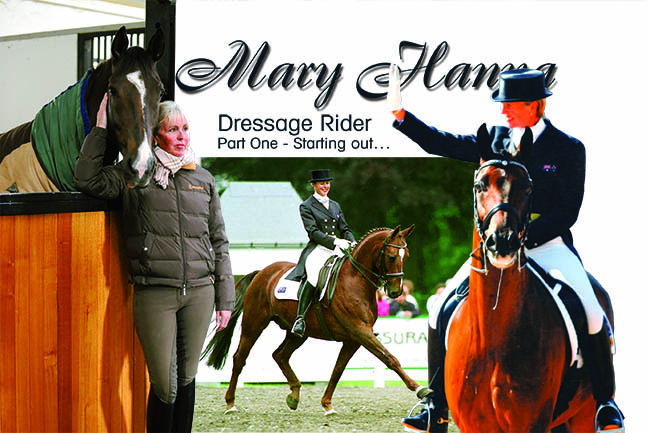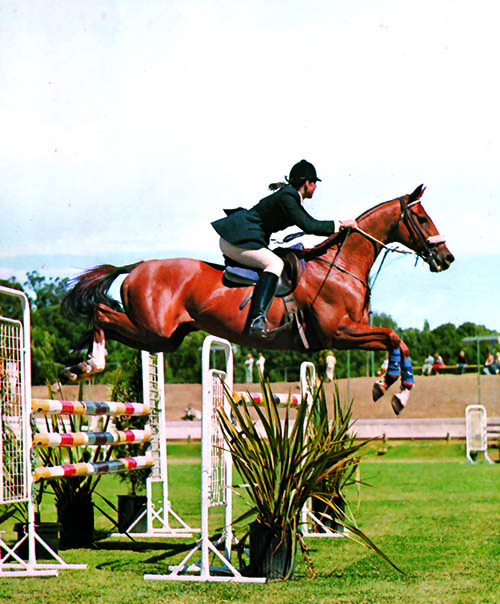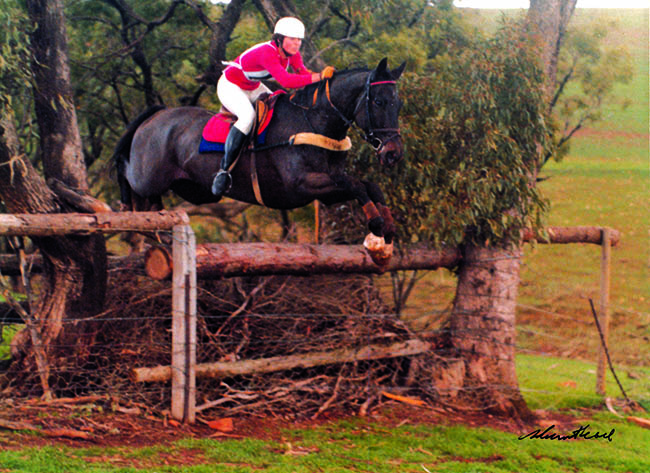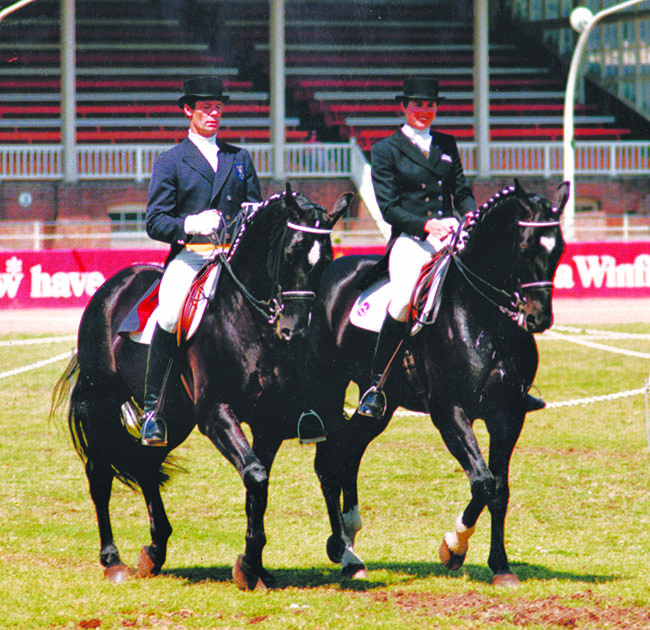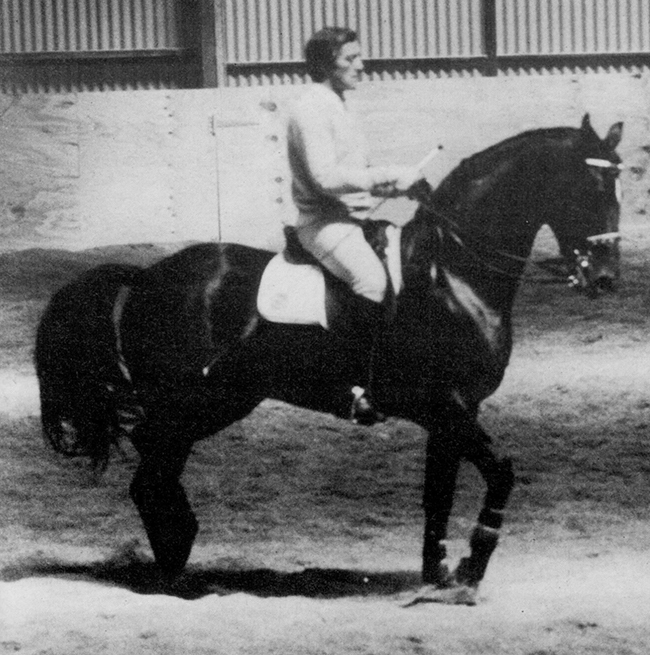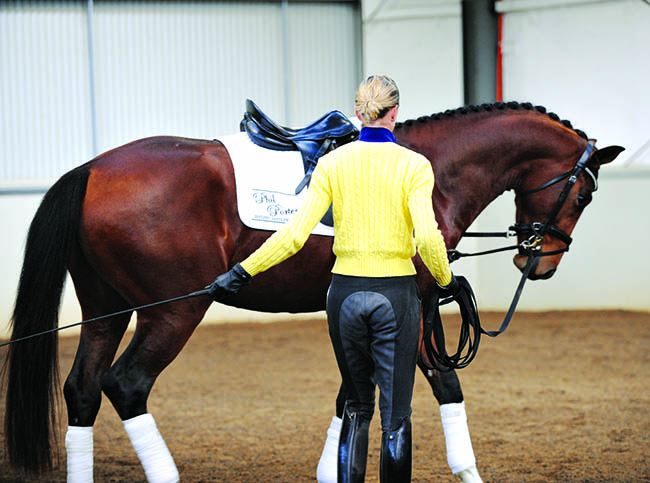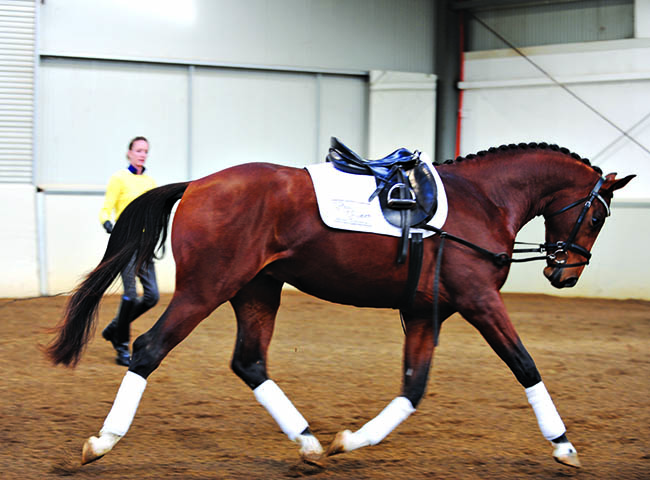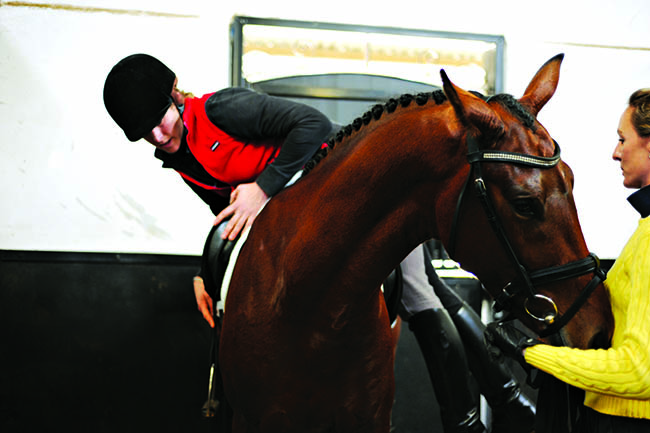Story – Chris Hector and Photos – Roz Neave and archives
Mary Hanna wears her years lightly. It really is hard to get your head around the fact that she first broke onto the Australian dressage scene in the early 80’s. In many ways, Mary Hanna’s story is the story of the coming of age of Australian dressage… and like many of our first dressage riders, Mary grew up with horses a part of her day to day life:
“Ours was a very horsey family, it was compulsory. If you didn’t ride you didn’t get fed practically. I lived on a property in the Western District and everybody rode. We rode to do the stock work, it was just part of life…”
“My mother was mad on jumping. She used to do a lot of hunting and she trained racehorses, and she used to go around all the shows around Australia riding in Section Fours when they galloped around the showgrounds jumping big jumps that looked like telephone poles… she was mad on that, and then she discovered the beginnings of dressage down in the Western District and became a bit interested in that, but eventing was always the main thing we were brought up on – eventing and hunting.”
Jumping was Mary’s first love…
“I went to Advanced as an eventer, and got on the short list for the World Championships in Kentucky on a horse called Suave. At the time I was absolutely obsessed, it was all I could think about, jumping fences and eventing, I absolutely loved it.”
Mary and Brûlée conquer the Gawler track…
So what caused the career change to dressage?
“After I married Gert Donvig, the first horse we bought was the Danish stallion, Kilof McOhl. In those days, they had strange rules about professionals. He was getting Kilof ready for what was called the Haig Cup – a Prix St Georges level competition that happened all over the world. About two weeks before the event, they rang and said, ‘Gert can’t ride Kilof because he is classed as a professional’. Gert said ‘what if Mary rides him?’ Okay. So I had a two week crash course riding Prix St Georges, Kilof was very kind to me – and I got really interested in dressage. I thought, this is fascinating. We did quite well, we came second to Erica Taylor and Crown Law, and from then on, I was hooked on dressage.”
“For quite a long time, I continued eventing and dressage. I had a very nice mare, Duell Way, that I used to own with Ralph Grosby. I took her to Heytesbury one day, she was a very brave mare but she should have been a showjumper not an eventer, she had quite a bascule… but she would never stop at anything. She was competing Prix St Georges and Advanced eventing at the same time. At Heytesbury she came into a big ditch, she just took off and basculed beautifully but didn’t get to the other side and smashed her face on the rail on the other side. I was lying next to her, looking at the blood streaming down her face, and I thought, no I’m not going to do this to this horse any more. I did event a couple of times after that because I had an owner / trainers steeplechase license, and I did event some of the steeplechase horses for their education.”
Who taught you about dressage?
“Gert was number one. In the early days we used to go to Hubert Eichinger from the Spanish Riding School, he was the first person, apart from Gert, who taught me. Earlier I went to Franz Mairinger when I was eventing, but I had a bad attitude, dressage was a strange thing you had to do before you got to the jumping part, you just suffered it. But I still remember some of Franz’s lines – one day I was fiddling a horse down on the bit, and he told me an old cow could be fiddled on the bit, but this was a dressage horse, and it wasn’t the way to do it. You remember a few of those classic lines…”
Gert and Mary and the two black stallions – Gert is on Granada, Mary on Kilof McOhl
I always had the impression that Gert had ridden a bit in Denmark before he came to Australia, but not to any high level, and he was prepared to make it up as he went along…
“He’d had a bit of influence from the trainer of Liz Hartels, but he was only trained in basic dressage. And you are right, he was a great improviser, and that is why he survived so well in the horse world, building up the business. He was flexible and he was a sponge, he just took everything from anyone. When he won the scholarship to go to Germany, and met Bimbo and all those people, he jumped right in and brought it all back home. Then he organized for me to go over there, to train with Bimbo, and then in Denmark.”
Bimbo perhaps doesn’t get the respect he deserves, in Germany lots of the top trainers and riders use him…
“He’s very influential. The thing about Bimbo was, every horse when you got on it after he’d sat on it, felt good. I know he was a tough guy and I think we’ve all become a lot more soft with the horses – and we are riding hotter horses – but every time you hopped on a horse after Bimbo had been riding it, it felt beautiful in the mouth, and hand and in the connection. He was very good at getting them engaged with the hind leg and soft in front. Connected but soft. He really knew how to get that feeling.”
Bimbo – who started so many riders…
It is different, starting your dressage career at Prix St Georges level…
“I knew how to steer around an Elementary test, and I was always fascinated by the training of the horse. I guess there was another incident earlier in my life which made me think about dressage and that was when I was very young and went to Warnnambool Show, and ‘Doc’ Mathews was riding Aintree Boy. I’ll never forget it – he rode Aintree Boy in a freestyle to ‘Greensleeves’ – I remember it was raining and it was under lights at night, the horse to my mind, did the most beautiful piaffe and passage – I was absolutely blown away, I can remember thinking, ‘for sure one day I want to do that.’ You see people in your early stages and if you see something that really grabs you, it influences you later.”
Next month Mary travels to Europe to train for the first time…
The LESSON: Training the Young Horse
“This young horse comes from the farm where I have bought several horses, from Wico Witte in Holland. When I was at the Bartels, I said to them, I’d like to buy a young horse. They said, there’s a place down the road, we’ve never had any success buying young horses from him, but I know he has a lot of youngsters by Jazz. Here’s his address, go and have a look. I bought Mayfield Pizzazz and a chestnut – the chestnut hurt itself so we didn’t bring it home.”
Perhaps it was a wrong decision – to sell Pizzazz…
“The reason I sold him was that he was tiny, how stupid was I? Did I not learn from Mosaic that size was not a problem? But I had three other horses at the time. We bought the horses and broke them in, and Kerry Mack came and bought Pizzazz when he was just broken in. He was just a charming horse to break in and do anything with. Then we bought Oskar B, as a two year old unbroken colt. He was a beautiful mover, and when we broke him in, he totally lost his movement. I thought, oh dear, I’ve made a mistake – and he was very colty. He had no concentration whatsoever.”
“He could seriously jump. I’d take him down the back paddock and jump him. I’d canter into the jump and he’d be looking up in the trees and just spring over the jump like it was nothing and canter off. In the end, I rang George Sanna and said, George I’ve got a horse here, I don’t think it’s going to make a dressage horse. He looked at it, and said ‘well he’s not going to make a jumper because he is not even looking at the jump, he has no concentration whatsoever…’ I thought ‘drat, I’ll geld him’. I worked him on, and he started coming to the party, but I also had Tango and I had to choose. I loved Tango, and Tango also came from Nicco, also by Jazz, and we broke him in too. I decided Tango was the one I loved, so we sold Oskar to Kate Taylor-Wheat, and that has been very successful.”
“The point is, if you go and buy a horse with the right breeding, and you bring it home as a baby, and you break it in yourself, and you do everything with that horse – then you know what you are getting. Even if you have problems on the way, in the end it’s often a better result than if buy a going horse. I got lucky with Mosaic, but as a general rule, I think buying a young one and breaking and doing all the work yourself, is the better way.”
Do you have any special system for breaking them in?
“It’s not so much a system, it’s simple. We lunge them. As long as it takes to have them round and steady and on the bit, really good in the connection and comfortable in the mouth. We back them in the stable, and we take as long as that takes. When we can lunge them perfectly, walk, trot and canter, and get on and off in the stable and they are absolutely relaxed about it – then we go into the arena and start riding them on the lunge, then off the lunge. There’s nothing special in it, it is just that you are not in a hurry. You do it yourself – the horse is in a familiar environment. As Lisa who works for me said yesterday, the trouble is that I get my horse back from the breaker and I don’t know anything about him. I’m told he’s broken in but I don’t know anything about him, and he doesn’t know anything about me. The ones you break in yourself, even if you are not a professional horse breaker, are always better. You and the horse have some sort of rapport.”
“We work them inside, then they go outside, then they go up the hill, out in the bush, take them to a competition, and so it goes. We just build up carefully…”
“You send a horse to the breaker and it is costing so much a day, and the breaker wants it done, and the next one in. They are there for six weeks if you are lucky and they are done in a hurry. It’s not that anyone is doing a bad job, it’s just that whole system is more likely to fail than if you can take your time and do the job yourself.”
“This young horse comes from Nicco. He doesn’t breed so many horses but he goes around and finds foals. He knows all the mares and all the breeding. This one was a bit of a surprise to me because I didn’t know anything about the mare line, but it was German and I figured a bit of solid German temperament mixed with the Jazz might go well. With Jazz, you’ve got to use a mare that’s pretty solid in the temperament.”
“The other thing about it when I go to Nicco’s to buy a horse, is that you can look at twenty of them in the paddock – you can see them move, you can see the size in comparison to the others, so you get a very good idea of how they rate compared to the others. I usually select a couple, bring them in, and then see them move in the indoor, look at their mechanics. Being able to choose is great instead of just going to look at one horse…”
And you are not paying a huge amount of money…
“My best ones were the cheapest, absolutely. There is an element of risk, you don’t know how they will break in but as a general rule, he knows the mares and he knows how the foals are likely to be. I bought this horse at the end of my trip last year, as an unbroken two year old, straight out of the paddock. Gitte had looked after the place the whole time I was away, and worked very hard for nothing – so this horse was her reward. I’ll do the right thing and buy my daughter a horse. We are in the middle of breaking him in.”
“We did a little with him at the beginning, then had to put him out because we ran out of stables. We just brought him in two weeks ago.”
Mary has moved into the indoor to supervise Gitte’s lunging session…
“We start to lunge them in the round yard, and the next step is to lunge them in here. It gets the horse used to the area, then we lunge them with the other horses in here, so they get used to working with other horses. We just try to make it comfortable for them.”
“This horse – as you can see – has a tendency to come back a little behind the bit – so we have to get him to really stretch forward. The Jazz’s can sometimes be a little fiddly in the mouth so you have to work to get them comfortable to take the connection. In the start of lunging, this horse really didn’t want to take the contact at all, and Gitte was putting them looser and looser, and I say, no, what you have to do now is take a little more connection and get the horse more into the bit. That’s the first thing.”
“When he is comfortable and working into the bit and he can do that in all three paces, then we can start to think about getting on. If they look as if they are going to buck or get a bit tricky, I’ll put the Pessoa gear on – that works round the back – I’ll use that too if they are a little bit lazy with their hind leg, but he is very good with his hind end. If I think they are really tricky, then I will drive them as well.”
“Jazz horses don’t usually buck so I would be surprised if this one did. He has lovely soft, straight movement.”
“It’s nice to see this young horse is not losing his movement the minute the saddle goes on. A lot of them do and it doesn’t mean they are not going to be good horses. If they move really well before they are broken in, and then lose it, give them time, and it will come back again. The Jazz horses tend not to move it when they are broken in. It was interesting with Oskar, I can remember Sjef Jenssen saying, ‘oh that’s normal for the Zeoliet’s to lose it when they are broken in, but it will come back..’”
Mary suggests an adjustment to Gitte:
“It would be nice if he would bend a little more to the inside but one thing at a time, he’s going against the rein a little bit, I’d like him to accept the outside rein a more and have a little more inside flexion. Try to point the whip at his shoulder – without making him go faster – and try for a little more inside bend, just feel, don’t jerk the rein, just feel as if you were riding him, through your wrist, just ask him to bend a bit.”
“Or even come back and try it in the walk, just gently feel with your inside rein, exactly, he can bend – that’s it. Walk on, he’s got to keep walking. If it is difficult in the trot, just try it in the walk, try and teach him a little inside bending, he’s got to accept the outside rein. Don’t let the rein go totally loose, it’s the same as if you are riding him, you’ve got to have a little connection – not a loose rein that suddenly goes tight, you’ve always got to feel that connection.”
“He has a tendency to drop the bit and he has got to come forward and accept the bit – even though it doesn’t look nice to see the horse behind the vertical, the only way to get him to accept the bit is not to give him a longer and longer rein, we have to take the rein and get him to take the connection and then take his nose further forward and out. If we just leave him on a loose rein all the time, he is never going to accept the bit. I don’t like to see them jammed up and too tight in the poll, but he is still at the stage where he hasn’t quite taken his nose forward to the bit, that’s what we’ve got to teach him to do on the lunge. He has to learn to lunge properly and take the connection.”
“Now to finish off, just put the rein a fraction longer and let me how he goes. Let’s see if we can get him to stretch forward a little more because you’ve had it quite short there. Now he has been there, he might stretch a little more. He has to go forward to it. You have to use your inside rein exactly the same as if you were riding him, with feel. He’s still trying to duck behind a little, a little bit more forward so that he takes the bit. Forward, let him have a little play, but forward – forward is better and now he is going better, go forward and into it, you’ve got to make him work a bit. I don’t mind if he has a buck, it doesn’t matter, he just has to go forward and take the bit. That’s better. That’s what he’s got to be able to do before we get on him. But they are all different, some are hollow and go up, some come behind, it is all part of being broken in, they have to accept the bit. But he is a soft little person so his response is to suck back a bit.”
“He’s not going to accept the bit if you just let him dawdle along, he has to go into the bridle, better, good, how does he feel in your hand?”
“He’s still leaning a bit.”
“Feel like little half halts through your wrist, just bending a little bit. He really bends the hind leg, he is loose in the shoulder, he is good in front and behind. Sometimes you get the hind leg bending but you don’t get the shoulder as well, plus he’s got a little bit of bending in the knee, and that is typical of the Jazz horses, they have a nice knee action.”
“He’s got such a great attitude, he’s listening, he is trying the whole time, he really wants to please.”
“We don’t have anything tricky with the bit, just a plain loose ring snaffle. If they have trouble turning, then I’ll put on a bit with a side piece, like an FM but if all is good, we start with a loose ring snaffle.”
“To finish take the side reins off and let him just walk and stretch…. Then back in the box and Lisa can do some getting on and off.”
And that’s just what we did, trooped around to the stable where Gitte held Brioni and Lisa climbed on and off. The work for the day was done.
This article originally appeared in the August 2009 edition of THM.



